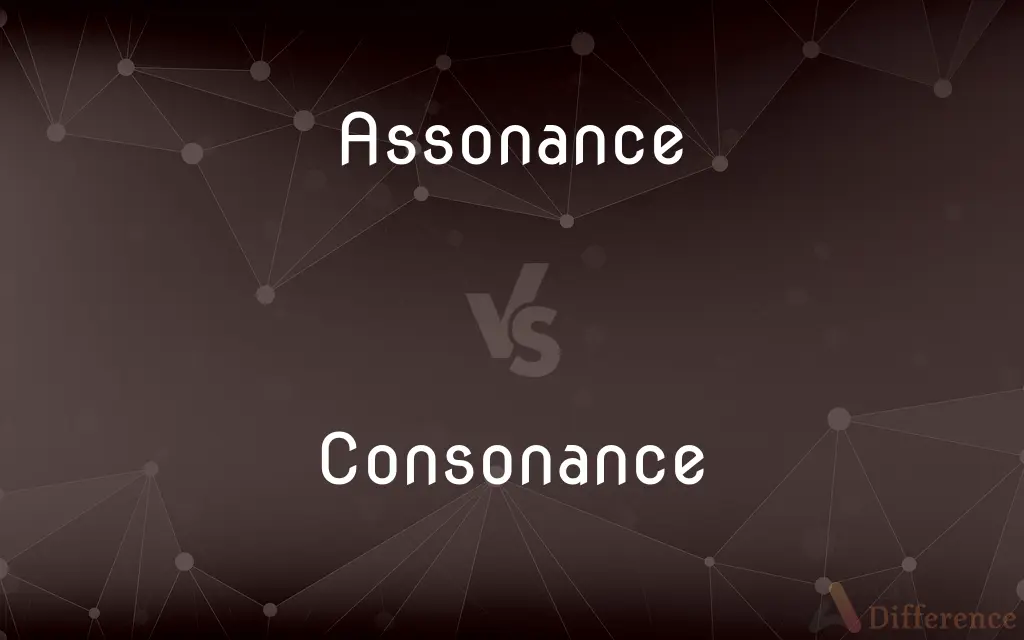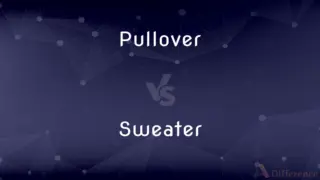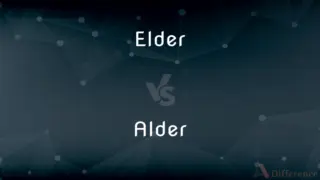Assonance vs. Consonance — What's the Difference?
Edited by Tayyaba Rehman — By Fiza Rafique — Updated on September 26, 2023
Assonance is the repetition of vowel sounds in nearby words, while Consonance is the repetition of consonant sounds at the end or middle of words.

Difference Between Assonance and Consonance
Table of Contents
ADVERTISEMENT
Key Differences
Assonance and Consonance are both literary devices used to introduce sound patterns within poems or prose. Assonance specifically pertains to the repetition of similar vowel sounds in a sequence of words, usually in the middle or at the end of words. This repetition can create a rhythmic quality to the text and can add a musical tone. An example of Assonance might be: "The rain in Spain falls mainly on the plain."
Consonance, on the other hand, deals with the recurrence of consonant sounds. This repetition can occur at the end of words but can also be found in the middle. Consonance provides texture and can imbue a poem or prose with a melodic tone. An instance of Consonance is: "She sang a song of sixpence."
While both Assonance and Consonance play pivotal roles in enhancing the beauty and rhythm of literature, they emphasize different sound elements. Assonance's focus on vowel sounds can produce a soft, mellow resonance, often evoking emotion. Consonance, by emphasizing consonant sounds, can create a starker, more defined beat or pattern in a piece.
Comparison Chart
Sound Focus
Vowel sounds.
Consonant sounds.
Position in Words
Typically middle or end.
Middle or end of words.
ADVERTISEMENT
Purpose
Introduce rhythm and mood.
Add texture and create memorable phrases.
Example
"The rain in Spain."
"She sang a song of sixpence."
Common in
Poetry to establish internal rhyme.
Both prose and poetry for catchy phrases.
Compare with Definitions
Assonance
The echoing of vowels in close or neighboring words.
Hear the mellow wedding bells.
Consonance
Repetition of consonant sounds in close proximity.
Pitter patter of tiny feet.
Assonance
A sound device that uses repeated vowel sounds.
Try to light the fire.
Consonance
Echoing consonant sounds within lines of a text.
Struts and frets his hour upon the stage.
Assonance
Repetition of similar vowel sounds in words.
Go and mow the lawn.
Consonance
Use of repeating consonant sounds for rhythm or emphasis.
Last but not least.
Assonance
Assonance is a resemblance in the sounds of words/syllables either between their vowels (e.g., meat, bean) or between their consonants (e.g., keep, cape). However, assonance between consonants is generally called consonance in American usage.
Consonance
Agreement; harmony; accord.
Assonance
Resemblance of sound between syllables of nearby words, arising particularly from the rhyming of two or more stressed vowels, but not consonants (e.g. sonnet, porridge), but also from the use of identical consonants with different vowels (e.g. killed, cold, culled)
Alliterative assonances such as ‘fail’ and ‘fall’ are very common in Old English poetry
The use of assonance throughout the poem creates the sound of despair
Consonance
Close correspondence of sounds.
Assonance
Resemblance of sound, especially of the vowel sounds in words, as in
"that dolphin-torn, that gong-tormented sea" (William Butler Yeats).
Consonance
The repetition of consonants or of a consonant pattern, especially at the ends of words, as in blank and think or strong and string.
Assonance
The repetition of identical or similar vowel sounds, especially in stressed syllables, with changes in the intervening consonants, as in the phrase tilting at windmills.
Consonance
(Music) A simultaneous combination of sounds not requiring resolution to another combination of sounds for finality of effect and conventionally regarded as harmonious or pleasing.
Assonance
Rough similarity; approximate agreement.
Consonance
(prosody) The repetition of consonant sounds, but not vowels as in assonance.
Assonance
(prosody) The repetition of similar or identical vowel sounds (though with different consonants), usually in literature or poetry.
Consonance
Harmony; agreement; lack of discordance.
Assonance
Resemblance of sound.
Consonance
Accord or agreement of sounds produced simultaneously, as a note with its third, fifth, and eighth.
Assonance
A peculiar species of rhyme, in which the last accented vowel and those which follow it in one word correspond in sound with the vowels of another word, while the consonants of the two words are unlike in sound; as, calamo and platano, baby and chary.
The assonance is peculiar to the Spaniard.
Consonance
Agreement or congruity; harmony; accord; consistency; suitableness.
The perfect consonancy of our persecuted church to the doctrines of Scripture and antiquity.
The optic nerve responds to the waves with which it is in consonance.
Assonance
Incomplete correspondence.
Assonance between facts seemingly remote.
Consonance
Friendship; concord.
By the consonancy of our youth.
Assonance
The repetition of similar vowels in the stressed syllables of successive words
Consonance
The repetition of consonants (or consonant patterns) especially at the ends of words
Assonance
A tool in literature to add rhythm through vowel repetition.
The beam of the gleaming moon.
Consonance
The property of sounding harmonious
Assonance
The mirroring of vowel sounds in poetry or prose.
The cat sat on the mat.
Consonance
A literary device that emphasizes repeating consonants.
Blank and think.
Consonance
The recurrence of consonant sounds, especially at the end or middle of words.
She will shriek when she's weak.
Common Curiosities
What is Assonance?
Assonance is the repetition of similar vowel sounds within words.
And Consonance?
Consonance is the repetition of consonant sounds, usually in the middle or end of words.
Can Assonance and Consonance occur in the same sentence?
Absolutely, a sentence can exhibit both Assonance and Consonance.
Are Assonance and Consonance types of rhymes?
Yes, both are considered internal rhymes, with Assonance focusing on vowels and Consonance on consonants.
Can Consonance be found in prose?
Yes, Consonance is found in both poetry and prose, often to create memorable phrases.
How does Assonance impact poetry?
Assonance can introduce rhythm, mood, and can emphasize specific themes or emotions.
How is Consonance different from alliteration?
While both involve consonant repetition, alliteration is specifically at the beginning of words, whereas Consonance can be in the middle or end.
Is Assonance common in everyday speech?
Assonance can be found in common phrases, song lyrics, and even slang, making it part of everyday speech.
How does Consonance affect the sound of a poem?
Consonance can add texture, rhythm, and can make phrases catchy or memorable.
Why would a writer use Assonance?
Writers use Assonance to create a musical quality, to emphasize emotions, or to establish internal rhyme.
Are Assonance and Consonance more style or substance?
They are stylistic devices but can significantly impact the substance or meaning conveyed, especially in poetry.
How do Assonance and Consonance relate to tone?
Both can influence the tone – Assonance might soften it with melodic qualities, while Consonance can make it more defined.
Can Assonance change the meaning of a sentence?
While Assonance primarily affects sound and rhythm, it can also influence interpretation or emphasis in some contexts.
Is it challenging to use Consonance effectively?
While using Consonance can be intuitive, mastering its effective use in literature requires skill and practice.
Is Consonance specific to English literature?
No, Consonance is found in many languages and literary traditions worldwide.
Share Your Discovery

Previous Comparison
Pullover vs. Sweater
Next Comparison
Elder vs. AlderAuthor Spotlight
Written by
Fiza RafiqueFiza Rafique is a skilled content writer at AskDifference.com, where she meticulously refines and enhances written pieces. Drawing from her vast editorial expertise, Fiza ensures clarity, accuracy, and precision in every article. Passionate about language, she continually seeks to elevate the quality of content for readers worldwide.
Edited by
Tayyaba RehmanTayyaba Rehman is a distinguished writer, currently serving as a primary contributor to askdifference.com. As a researcher in semantics and etymology, Tayyaba's passion for the complexity of languages and their distinctions has found a perfect home on the platform. Tayyaba delves into the intricacies of language, distinguishing between commonly confused words and phrases, thereby providing clarity for readers worldwide.
















































